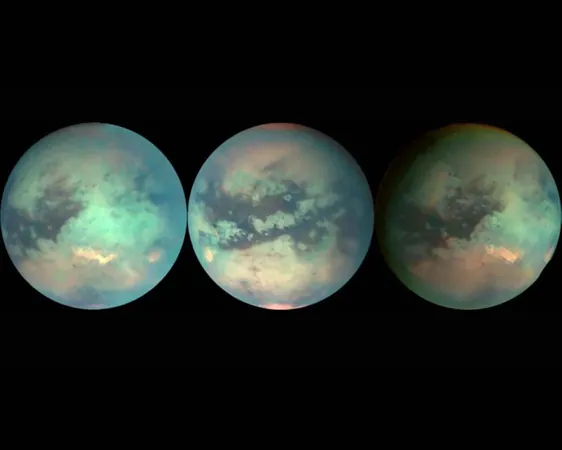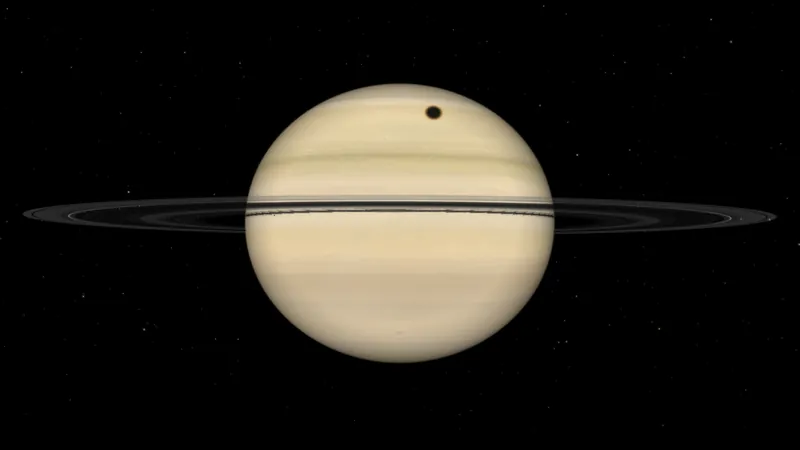
Titan's Surreal Weather: Methane Lakes and Alien Clouds Await Discovery
2025-05-21
Author: Wei Ling
Exploring Titan: A World of Mysteries
Saturn's enigmatic moon, Titan, resembles a hazy, yellow sphere when viewed from the cosmos, cloaked in thick clouds that hide a fascinating landscape beneath its surface. Despite its otherworldly appearance, Titan shares some striking characteristics with Earth, including clouds, rain, and lakes. The key difference? Titan's weather operates on methane instead of water.
Unveiling Titan's Clouds
Recent observations by the James Webb Space Telescope alongside the Keck II Telescope have unveiled new evidence of rising methane clouds in Titan's northern hemisphere. Scientists are particularly excited about the discovery of a rare carbon-based molecule, hinting at the moon's complex atmospheric chemistry.
Titan's Unique Seasonal Weather Patterns
Researchers from NASA's Goddard Space Flight Center and W.M. Keck Observatory monitored Titan during its summer months in late 2022 and mid-2023. They recorded the formation of methane clouds high in the northern hemisphere, where lakes and seas are abundant, showcasing a weather pattern reminiscent of Earth.
Methane behaves much like water in Earth’s climate: it evaporates, rises, condenses into clouds, and sometimes falls as rain. However, there's a critical difference: Titan's frigid surface can freeze water solid, meaning the rain here is a cold, oily drench that lands on ice as hard as rock.
Mapping Titan's Atmosphere
The recent images reveal these clouds rising over several days, indicating active convection—an atmospheric process where warm gases ascend. This phenomenon had previously only been recorded in Titan's southern hemisphere.
Titan's extensive northern lakes, covering an area comparable to North America's Great Lakes, likely contribute methane to the atmosphere, essential for cloud formation. With a lower gravity, Titan’s troposphere extends to approximately 27 miles high, dramatically taller than Earth’s 7-mile troposphere.
The Search for Life's Building Blocks
The fascination with Titan extends beyond its weather; the moon's rich carbon chemistry raises questions about the origins of life. Methane, a cornerstone of Titan's chemical processes, breaks down under sunlight or charged particles, leading to the formation of ethane and other complex molecules essential for potential life.
Groundbreaking Discoveries in Titan's Chemistry
One of the most thrilling findings from the Webb telescope observations was the identification of a fleeting substance known as the methyl radical (CH3). This intermediate product of methane decomposition had never been directly observed before, allowing scientists to study chemical reactions in real-time.
As researcher Stefanie Milam put it, this marks the first time we can glimpse the 'chemical cake' while it's still baking, highlighting a new era of atmospheric research.
Titan's Future: A Rocky Road Ahead
But Titan's methane reserves pose a critical question about its future. As methane breaks down, some hydrogen escapes into space, which could deplete Titan’s atmosphere unless replenished from beneath its crust. This process bears similarities to Mars, where evaporated water left the planet dry over time.
Conor Nixon warns that without a sustainable source of methane, Titan risks becoming a lifeless expanse of dust and dunes.
Preparing for the Dragonfly Mission
While the telescopes provide valuable insights from afar, the upcoming NASA Dragonfly mission promises a closer examination. Set to launch in 2034, this innovative flying drone will land on Titan and directly explore its rugged surface and intricate chemistry.
Heidi Hammel emphasizes the importance of integrating data from various observatories to create a comprehensive understanding of Titan, linking discoveries to prior missions and paving the way for future revelations.
Join the Adventure!
With Titan's weather and chemistry open for exploration, scientists are set to unveil its secrets, one methane cloud at a time. Stay tuned for the incredible discoveries this alien world has yet to reveal!




 Brasil (PT)
Brasil (PT)
 Canada (EN)
Canada (EN)
 Chile (ES)
Chile (ES)
 Česko (CS)
Česko (CS)
 대한민국 (KO)
대한민국 (KO)
 España (ES)
España (ES)
 France (FR)
France (FR)
 Hong Kong (EN)
Hong Kong (EN)
 Italia (IT)
Italia (IT)
 日本 (JA)
日本 (JA)
 Magyarország (HU)
Magyarország (HU)
 Norge (NO)
Norge (NO)
 Polska (PL)
Polska (PL)
 Schweiz (DE)
Schweiz (DE)
 Singapore (EN)
Singapore (EN)
 Sverige (SV)
Sverige (SV)
 Suomi (FI)
Suomi (FI)
 Türkiye (TR)
Türkiye (TR)
 الإمارات العربية المتحدة (AR)
الإمارات العربية المتحدة (AR)